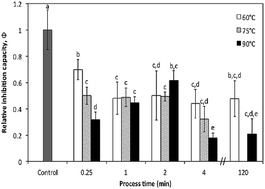The effect of heat treatment of thylakoids on their ability to inhibit in vitro lipase/co-lipase activity
Abstract
Thylakoids has been shown to prolong lipolysis by the inhibition of lipase/co-lipase, which makes thylakoids suitable as a functional food ingredient with satiating properties. The components of thylakoids that provide its function as a lipolysis modulator are primarily photosystems I and II, which are structurally stabilised by chlorophyll. However, chlorophyll is known to be heat sensitive yet the enzymatic inhibiting capacity after heat treatment has not been previously studied. It was hypothesised that the retained function of thylakoids after heat treatment could be correlated to the degree of degradation. Heat treatment at either 60 °C, 75 °C or 90 °C for time interval ranging from 15 s to 120 min induced a color shift from bright green to olive brown which was attributed to degradation. The ability of heat-treated thylakoids to inhibit lipolysis in vitro was also reduced. A correlation between chlorophyll a degradation and the enzymatic inhibiting capacity could be established which opens possibilities to use a spectrophotometric method to quantify the ability of thylakoids to inhibit lipase/co-lipase in a more rapid and cost effective way to complement the pH-stat method used today. With the degradation pattern investigated, it is then possible to design a thermal treatment process to ensure a microbiological safe appetite-reducing product and at the same time minimize the loss of functionality.


 Please wait while we load your content...
Please wait while we load your content...